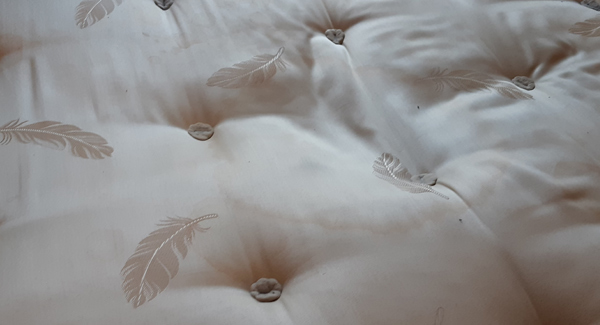Home » Mattress advice » Can A Soft Mattress Cause Back Pain?
Can a soft mattress cause back pain?
Article navigation
- Published:
- Written by: Tony Brown
- Topic: Mattress advice
Various factors can contribute to back pain, including the type of mattress you sleep on. Sleeping on a mattress that does not correctly support the body can cause or worsen back pain and contribute to poor-quality sleep. Therefore, choosing the correct mattress firmness is essential to ensure the body is aligned and properly supported.
The ideal mattress firmness will vary for each person. Whilst a soft mattress may feel uncomfortable for some individuals, others may prefer a plush, cushioned feel that cradles the body. However, soft mattresses also have their drawbacks. While they conform to the body and offer good pressure relief, excessive sinking into the mattress can lead to discomfort and back pain.
How do you know if a mattress is too soft?
Mattress firmness often comes down to personal preference. However, factors like body weight, build, height, and preferred sleeping position can also have a significant impact. Here are some signs that might suggest your mattress is too soft.
Body weight
Body weight is one of the most significant factors when choosing a mattress. Soft mattresses are typically recommended for individuals weighing less than 11 stone (70 kg). Heavier individuals may find that a softer mattress allows them to sink too deeply into the mattress, resulting in misalignment.
Sleeping partners may have varying comfort preferences and firmness needs because of weight and size differences. This can present a challenge when choosing a mattress that caters to both partners’ needs. In many cases, compromise becomes necessary, where one or both partners choose a mattress that does not provide adequate support.
Sinking sensation
Heavier individuals may experience sinking issues with soft mattresses. They might feel trapped in the mattress, making it hard to change positions or get out of bed. In some cases, individuals may need to use extra force or pressure to get themselves out of bed due to the softness of the mattress.
Lack of support or misalignment
Misalignment is one of the more obvious indications a mattress is too soft. Ideally, the mattress should conform to the shape of the body, keeping the spine in a relatively straight and neutral position. A mattress that is too soft will cause the body to bow or curve, putting the spine in an unnatural position.
A handy check to determine if a mattress is too soft is to lie on your back and slide your hand underneath the lumbar region of your back. If you struggle to slide your hand underneath your back, this may indicate the mattress is too soft. On the other hand, the mattress is probably too firm if you can slide your hand underneath your back easily. You should be able to slightly slide your hand underneath your back with a little bit of resistance.
Alternatively, you can ask someone to check if your spine is aligned when lying on the mattress. Ask them to take a picture from their phone so you can check for yourself.
Your preferred sleeping position can also contribute to back pain. Side sleepers typically prefer a softer mattress that cushions the shoulders and hips. However, back and front sleepers usually require a firmer mattress. Furthermore, sleeping on a soft mattress when lying on your front puts significant strain on the neck muscles.
Visible sagging
Over time, softer mattresses can start to sag and feel uncomfortable, often due to wear and tear. A sagging mattress puts the spine out of natural alignment and will not provide adequate support. Some individuals may feel like they are sinking too deep into the mattress, a feeling often described as ‘bottoming out’, and may find it harder to turn over in bed.
If your mattress is lumpy, misshapen, or sagging, it won’t miraculously improve with time and should be replaced.
However, when a mattress is new, indentations and body impressions may form on the surface. This is referred to as settlement and does not necessarily mean the mattress is faulty. Regularly turning the mattress, especially during the first few weeks or months of use, helps the upholstery to settle more evenly.
You’re sleeping on a new mattress
When you switch to a new mattress, you may initially experience discomfort or back pain. This is perfectly normal, as it takes time for your body to adjust to the new mattress, particularly if it feels noticeably different from the old one. Like a new pair of shoes, your body needs to ‘break in’ a new mattress. This adjustment period can be unpleasant at first. However, the new mattress should feel more comfortable after a few weeks.
In particular, transitioning from a sprung mattress to a memory foam mattress can be quite an adjustment. Memory foam gently moulds and adapts to body shape and can feel noticeably softer than ordinary mattresses.
Some manufacturers offer trial periods on new mattresses. If you’re still unsatisfied after the breaking-in period, you may have the option to return it. This allows you to find a mattress that suits your comfort and sleep needs without the risk of being stuck with an uncomfortable one.
Morning stiffness
If you wake up feeling sore or experiencing aches and pains, especially when you feel fine before bedtime, it could be a sign that your soft mattress is not supporting you correctly.
Poor-quality sleep
Your mattress may contribute to poor-quality sleep. An effective way to determine this is to spend a few nights sleeping in a different bed. If you experience a better night’s sleep, you may need to replace your mattress.
How to make a soft mattress feel firmer?
You can make your mattress firmer without necessarily replacing it. The bed base you use with your mattress can affect how it feels and performs. For instance, a sprung base can make a bed feel softer, while a solid base or one with rigid slats can make it feel firmer. If you notice your mattress is paired with a sprung base, placing a smooth sheet of plywood board on top of the base should provide a firmer feel. Remember to drill holes in the board for ventilation.
Some mattresses typically perform better on certain bed bases. For example, most memory foam mattresses perform better on slats on solid bases. Because memory foam softens with use, some people, particularly heavier individuals, may experience over-sinking. Placing a memory foam mattress on a sprung base can worsen the problem.
Another common issue is placing a new mattress on an old bed base. Over time, the base weakens. It may start to lose its shape and sag. The new mattress will simply take the shape of the old base, dipping in the same areas.
Therefore, it’s crucial to ensure the mattress and the base are compatible, ideally replacing both together.
You can also consider using a firm mattress topper. However, a topper may not improve the feel of an old worn-out mattress.
Avoid placing your mattress directly on the floor. While it may feel firmer, the poor airflow underneath the mattress can lead to mould and mildew growth. Sleeping close to the ground exposes you to cold air, dust, and pests.
Should you replace a soft mattress with a firmer mattress?
For many years, it was felt that a firm mattress was better for a bad back. Doctors and medical professionals would even recommend placing a sheet of board underneath the mattress to make it feel firmer. However, individuals would often experience discomfort and painful pressure points when sleeping on a firm mattress.
Typically, the heavier you are, the firmer your mattress should be. You don’t necessarily need a firm mattress, but it should be comfortable, supportive and conform to the shape of your body.
A split tension mattress is perfect for couples with different comfort preferences or varying weights. It allows each person to have their preferred mattress firmness on their side of the bed, eliminating the need for compromise. For instance, one partner can choose soft support on their side of the bed, while the other can have medium support on theirs. Spilt tension mattresses are typically available in 5’0” king size models and wider.
Alternatively, zip and link is a flexible option that allows you to combine two single beds to create a king or super king size bed. With this setup, sleeping partners can choose to sleep together or separately, and each person can have their side of the bed in their preferred mattress firmness.
Hybrid models offer an excellent compromise for those who prefer memory foam but find it too soft or prone to sinking. These mattresses combine springs and foam, providing a slightly bouncier feel, making it easier to turn over in bed.
Another option is latex. Like memory foam, latex conforms to the body and offers pressure relief. However, it has a bouncier feel and quickly responds when pressure is removed, making it easier to change sleeping positions.
Finally, be wary of mattresses labelled ‘orthopaedic’ or ‘posturepedic.’ While these terms may suggest that these mattresses are medically endorsed and designed to alleviate back pain, they are primarily marketing terms used to describe firm mattresses.
Final thoughts
Comfort is subjective, and what feels comfortable to one person may feel uncomfortable to someone else. Try different models in a local store when shopping for a new mattress. If you share a bed, shop together to ensure you’re both satisfied with your choice. Finally, if you’re unsure what mattress firmness to choose, consider your body weight as the primary factor.
Share this article

About the author
Tony Brown is the founder and creator of The Bed Consultant. His career in the bed industry began in 2002. After graduating from university with a degree in Business Administration, Tony joined one of the largest independent furniture retailers in the UK as a bed consultant. Tony has helped thousands of customers find the perfect mattress.




